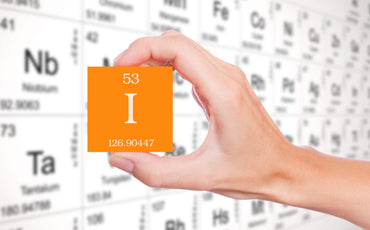
Puberty is a vital process of transitioning between teenage years and adulthood, which results in physical developments of sexually matured behaviours and body features. In addition to these sexual developments, puberty also initiates different physiological changes that result in rapid somatic growth, brain development, and attainments of reproductive capability. Disorders of puberty can impact the emotional and psychosocial well-being of a teenager. Many clinical surveys are linking these disorders to congenital abnormalities and thyroid dysfunctions in teenagers. Thyroid dysfunctions in adolescent or young adults during pubertal developments, can increase the risk of infertility, menstrual dysfunction, stillbirth, or premature birth. Correcting the abnormalities of the thyroid gland and optimizing thyroid health with adequate iodine supplementation, such as that offered at TriFixx™ through Iodine Fixx™, has long been proposed for pubertal disorders. Supporting the thyroid further, by consuming nutraceuticals which optimize thyroid performance (Thyroid Fixx™ & D3/K2 Fixx™) where required, can easily save many from the horrible symptoms often experienced throughout puberty.
INTRODUCTION
Puberty
Discussion on puberty has a special place on the awareness schedule of NGOs, regional health agencies, and primary healthcare facilities, across the globe. At a point, you might have also contributed to these discussions. As an adult, you might remember a point when your body was going through a lot of developmental changes that affected your physical, emotional, mental, and physiological health. For every moment of your pubertal changes, you sure have a lot of experience to relate. How did you navigate through this long process of change? Did you know some therapies could have easily saved you the horrible experiences of pubertal development? Only a few adults understand the clinical relevance and possible interventions available for teenagers going through this transition period of life.
With the exemption of some rare cases of hormonal dysfunctions, puberty happens to all. Come a point in life, both sexes experience a rapid body change that occurs progressively with ageing. This vital process of transitioning between teenage years and adulthood results in physical developments of sexually matured behaviours and body features. In addition to these sexual developments, puberty also initiates different physiological changes that result in rapid somatic growth, brain development, and attainments of reproductive capability. These changes translate to physical modification of the body, with hair growth, voice changes, breast developments, large and broad chest, and the experiences associated with the periodic menstrual cycle in females.
How Does It Happen?
Puberty changes are physiological and depend on individual variation. Health, sex, and race variations have been studied to better characterize the onset of puberty in teenagers. For a typical African America girl, puberty starts around 6 years of age. In Caucasian girls, this transitioning process starts around the ages of 8 and 13. The whole process of emotional, physical, and sexual maturity starts with a phase of rapid linear growth. It is easy to miss this phase and think it never happened. During this period, the body organs initiate a series of rapid cell maturation and development that increases the body's physical features in general. The most notable signs of this phase are breast development in girls and a rapid increase in height for boys.
This first phase of puberty – Adrenarche - witnesses many actions of the adrenal androgens in teenagers. This timing has also been linked with a series of social changes and behaviours that might constitute a risk for mental health problems. The Body Mass Index (BMI) also changes as height and body weight increase significantly. In a 2008 publication of the Journal of Clinical Endocrinology and Metabolism, researchers found that teenagers exhibiting premature adrenarche have abnormal levels of insulin. This study confirmed early reports suggesting that the endocrine system plays an essential role in regulating and monitoring the physiological cycle of puberty. Many research studies have also highlighted the importance of thyroid hormones, adrenal gland hormones, and reproductive hormones in regulating puberty.
The second phase of puberty – Gonadarche - is characterized by sexual maturation and achievement of reproductive capacity in teenagers. Gonadal hormones are produced in excess bursts to stimulate the growth and development of secondary sexual characteristics. The development extends beyond the reproductive system, with noticeable effects on the central nervous system. During gonadarche, the endocrine system develops rapidly. Growth hormones, thyroid hormones, and insulin-like growth factors are produced to further regulate the physiological changes and monitor subsequent phases of puberty. This is where the thyroid gland comes into play during puberty. In girls, menarche (the onset of the menstrual cycle) occurs in late in the puberty cycle. Within four years, puberty is generally completed. Abnormalities in the production and activity of hormones such as gonadal, steroid, and thyroid hormones, can upset puberty and cause health symptoms that make the process a terrible experience for a teenager.
Effect of Puberty on Health and Disease
Puberty is a complex physiological process of cellular reorganization, maturation, and specialization. In addition to the physiological changes associated with puberty, there are series of hormonal regulations and monitoring required during the different phases. An abnormality in the functions of the regulatory mechanisms can cause serious health implications for the growing teenager. In a 2009 publication of the European Journal of Endocrinology, Hochberg affirmed that higher BMI rates accelerate the onset of puberty, fast-tracking the cycles and causing a rapid, unexpected burst of hormones involved in the regulation of puberty. You might have noticed these changes linked with accelerated puberty in a teenager who is overweight or obese. Separate research studies are suggesting that these early pubertal changes also increase the risk of fat accumulation in adulthood.
Early pubertal timing and associating health complications is a common theme for many studies researching hormonal effects on puberty. A publication of the International Journal of Obesity documented the link between early puberty and its link with increased risk of: cardiometabolic syndrome, type 2 diabetes, high blood pressure, and cardiovascular events. In early puberty, there is long exposure to gonadal steroids and other hormones regulating the pubertal phases. Increased exposure to these hormones at this early stage of life has also been linked to an increased risk of steroid-dependent cancer in later stages of adolescent life. Additionally, in females, the risk of breast and ovarian malignancies increases; whilst in males, the prolonged exposure increases oxidative stress that sets the course for possible prostate cancer.
Puberty Disorders
Disorders of puberty effect can impact the emotional and psychosocial well-being of a teenager. Many clinical surveys are linking these disorders to congenital abnormalities and endocrine inadequacies in teenagers. These causes have been documented in both teenage boys and girls. In most cases, these disorders are linked with endocrine inadequacies.
Among this population study, there is full precocious activation of the hypothalamic-pituitary-gonadal axis and the premature maturation, excess production of hormones of the thyroid, and insulin-like growth hormones. These endocrine implications have prompted much research into understanding how the thyroid hormones and growth factors help regulate the pubertal timing in teenagers. Clinical researchers have also identified the possibility of supplementing these hormones early in life to reduce the risk of puberty disorders and their symptoms in teenagers.
Precocious Puberty
Precocious puberty is diagnosed when the secondary sexual characteristics and body growth features associated with normal puberty are noticed in teenagers younger than 8 years for boys, and 9 years for girls. Just as in the onset of a normal pubertal cycle, precocious puberty has a health, race, and sex variation. Obese teenagers are particularly vulnerable to the endocrine abnormalities that occur in precocious puberty.
In 2019, the Annals of Pediatric Endocrinology and Metabolism published the result of a novel research study examining the link between thyroid function in girls with central precocious puberty (CPP). The study used a participant pool of 1,247 girls aged between 6 and 9 years who had undergone hormonal stimulation to determine the presence of puberty. Serum TSH levels were evaluated in these girls to better understand the role of the thyroid hormones in disorders of puberty. Research results showed significant variations in serum TSH and serum FT4 levels in girls with CPP and those with normal pubertal cycle. Clinical evaluation of this case starts with a complete workup of hormonal inputs and another regulatory mechanism of this transitioning phase.
Delayed Puberty
Delayed puberty is characterized by the absence of noticeable signs of breast development by age 13 in girls or the absence of noticeable signs of testicular maturation in boys (by age 14). In many cases, the features may remain absent a few years after age 13 in girls, and age 14 in boys. Delayed puberty can also present as consistent halting or regression of pubertal changes. This means the development of secondary sexual characters may remain stunted for a long time.
Pubertal Changes and Thyroid Hormone Regulation
The thyroid hormones are known for their essential functions in regulating the stages of growth and development from birth to adulthood. Through these stages of a human's life, the thyroid hormones, in their free and bound form, work in concert with other inputs from the hypothalamus-pituitary-gonadal axis to: time puberty, regulate the hormonal secretions and modify the physical manifestations of this transitioning period. There is much research evidence highlighting the importance of this complex interaction during puberty.
The complete picture of how far the thyroid gland is involved in puberty regulation is still largely unknown. However, clinical surveys and have shown that the levels of thyroid hormones fluctuate regularly as puberty progresses. The functioning has been linked to different physiological rearrangements and specialization of organ systems in the body.
In 2003, the Journal of Pediatric Endocrinology and Metabolism published a reference study on the link between normal thyroid function and the puberty cycle in teenagers. Results from this study suggest that hypothyroidism diagnosed late in prepubertal years – usually due to Hashimoto's thyroiditis - increases the risk of delayed puberty or incomplete isosexual precocious puberty.
Hyperthyroidism also influences the pubertal cycle even when present for a considerably long period. Although the mechanisms by which hyperthyroidism affects pubertal changes are not yet well understood. Thyroid dysfunctions in adolescent or young adults during pubertal developments can increase the risk of infertility, menstrual dysfunction, stillbirth, or premature birth. These observations have raised a lot of questions about the need to investigate thyroidal regulation of pubertal changes in teenagers. If the biological mechanism of this interaction is known, thyroid hormone supplementation and iodine supplementation can be explored as an adjunct therapy for the horrifying symptoms of puberty in teenagers.
Although the exact involvement of the thyroid hormones in pubertal regulation is still under investigation, the changes in thyroid hormone levels during puberty are well documented. Free T3 has been discovered to play a major role in timing the onset of puberty. Abnormal fluctuations in the levels of these thyroid hormones have been linked with delayed puberty and stunted growth. T3 levels are significantly higher during childhood and puberty than in adulthood. This suggests that the functions of this hormone are more essential during the transitioning period of puberty and adolescence. During puberty, free T3 levels are higher in teenagers with a high body mass index (overweight or obese) as puberty progresses. There is also clinical evidence suggesting a high conversion rate of free T4 to free T3 during childhood and puberty. These hormones serve regulatory functions and directly influence the development of secondary sexual characteristics in teenagers.
Studies and Clinical Case Studies Linking Thyroid Health with Puberty
Hypothyroidism is considered the most common disturbance of thyroid function in teenagers. Early evidence linking hypothyroidism with pubertal symptoms was published in 2008 by the Journal of Pediatric Radiology. In this study, children with hypothyroidism associated with precocious puberty were evaluated for six years. The study confirmed that delayed puberty and other symptoms are a common manifestation of untreated hypothyroidism in teenagers. Symptoms of this condition start at the thelarche and persist until menarche. The first physical manifestation of this condition was poor development of pubic hair and a decreased linear growth, especially in girls. The presence of a retarded bone age in teenagers diagnosed with delayed puberty can also suggest an abnormality of the thyroid gland.
Another study linking an abnormal thyroidal function to problems with the normal puberty cycle was published in 2011 by the Indian Journal of Endocrinology and Metabolism. This study reviewed the case of a 10 years 9 months’ girl who presented with progressive breast enlargement and menarche at just 7 years of age. She had normal milestones of development and has been experiencing regular menstrual cycles with the average flow. A diagnosis of delayed puberty was confirmed with enlarged ovaries suggesting an estrogen-secreting ovarian tumour. However, the finding of a delayed bone age with precocious puberty narrowed the diagnosis down to longstanding untreated hypothyroidism. High circulating levels of Thyroid-stimulating hormone (TSH) also suggested Van Wyk-Grumbach Syndrome – a condition that describes hypothyroidism associated with precocious puberty.
The exact mechanism of the development of precocious puberty in Van Wyk-Grumbach Syndrome is unknown. However, it is postulated that a lack of specificity in the feedback mechanisms regulating puberty causes an overproduction of multiple hormones. The thyroid hormones are involved in regulating this feedback mechanism. Teenagers with Van Wyk-Grumbach Syndrome also present with consistently elevated TSH levels. In early studies investigating thyroidal functions in puberty, a high circulating level of TSH acting directly on the FSH receptors has been shown to increase the risk of precocious puberty. The interaction also manifests physically as different undesirable symptoms associated with puberty.
The Trials and Tribulations of Puberty
If the process of puberty remains uncomplicated with hormonal inadequacies or congenital malformations, most signs and symptoms at puberty are mild and expected. In girls, the growth of pubic hair and other body hair, growth spurts, breast development, a burst of acne, and the onset of menstruation. In boys, the expected signs and changes include growth of pubic hair, enlargement of the testicles, muscle growth, acne, and deepening of the voice. Health agencies and childhood support organizations consistently inform teenagers about these changes, what to expect and how to deal with them. However, in disorders of puberty, the changes and symptoms documented are unexpected and sometimes very serious. Many times, the symptoms associated with disorders of puberty as caused by hormonal inadequacies are tagged as the ‘trials and tribulations of puberty’.
In girls, these trials may be disturbing and impair the mode of normal, healthy living. Precocious puberty complicated with hypothyroidism usually present with vaginal bleeding and sometimes with breast development or galactorrhea. When poorly managed, heavy vaginal bleeding can adversely affect the Packed Cell Volume (PCV) and cause different forms of anaemia. The results of this complication can be damaging during the period of pubertal changes. In these girls, there can also be a lack of pubic hair despite an early onset of puberty. In boys, the presentation varies. There can be an exaggerated testicular enlargement with no significant signs of virility. Hypothyroidism affects the developing testis, leading to over-proliferation of Sertoli cells and resultantly enlarged testes. The TSH levels are high; there is a lack of pubic hair and a delayed bone age.
In both sexes, the abnormality in TSH levels has been linked with over-stimulation of the gonads in precocious puberty. The level of stimulation observed cannot be completely explained by elevated levels of gonadotropins in puberty. In females, the circulating gonadotropins and the effect of severe hypothyroidism may cause multicystic ovaries. In girls with isosexual pseudo precocity, the presence of palpable adrenal mass may suggest an early stage of ovarian cancer. In many cases, these undesired symptoms may present with other complications that affect organ systems that are not entirely involved with the processes of pubertal regulation. Hormonal inadequacies during puberty may also exaggerate the normal symptoms expected during puberty. The acne breakouts may be severe and take a long time to resolve.
The psychological price of these ‘trials and tribulations’ are huge and can adversely influence the emotional health of affected teenagers. Teenagers who experience hormonal disorders during puberty may become overly self-conscious, develop symptoms of emotional withdrawal, and become socially reclusive. They can initiate different complications, including unexplained bouts of anxiety, anger, depression, and suicidal tendencies. The risk of Substance Abuse and anti-social behaviours is also increased significantly in these teenagers.
Preventing/Correcting Puberty Disorders with an Optimized Thyroid
The idea of hormonal supplementation is not entirely new in human medicine. Pubertal disorders and symptoms are closely linked with hormonal inadequacies and dysfunctions of the thyroid. Correcting the abnormalities of the thyroid gland and optimizing thyroid health with adequate iodine supplementation has long been proposed for pubertal disorders. It is widely considered that a healthy thyroid can help prevent the undesirable symptoms of puberty. Over the last decade, there have been multiple research pieces of evidence supporting thyroid optimization as a therapy for pubertal disorders.
Early evidence was published in 2011 by the Indian Journal of Endocrinology and Metabolism. Researchers evaluated an unusual case presentation of hypothyroidism associated with precocious puberty. The patient presented with several symptoms of pubertal disorders as a complication of long-standing untreated hypothyroidism. Symptoms presented include ovarian cysts and multiple endocrine abnormalities. After treatment with thyroxine replacement, all symptoms resolved spontaneously.
Bottom Line
Supplementing the thyroid with an adequate amount of dietary iodine is considered an effective method of preventing/correcting pubertal disorders. Iodine is an essential component of thyroid hormones. As a micronutrient, it is needed by the thyroid gland to make its hormones. TriFixx™ Iodine Fixx™ is formulated to provide the right amount of iodine for teenagers. This product supplies 12.5 mg of iodine per unit – enough to meet the daily intake recommendation for iodine. By supplying the iodine needed for the body, iodine supplementation can effectively prevent, or correct pubertal disorders linked with hormonal inadequacies of the thyroid gland.
Related Products
REFERENCES















